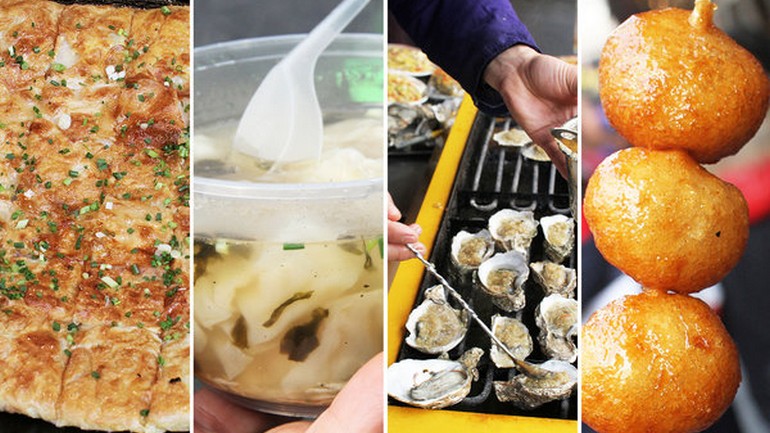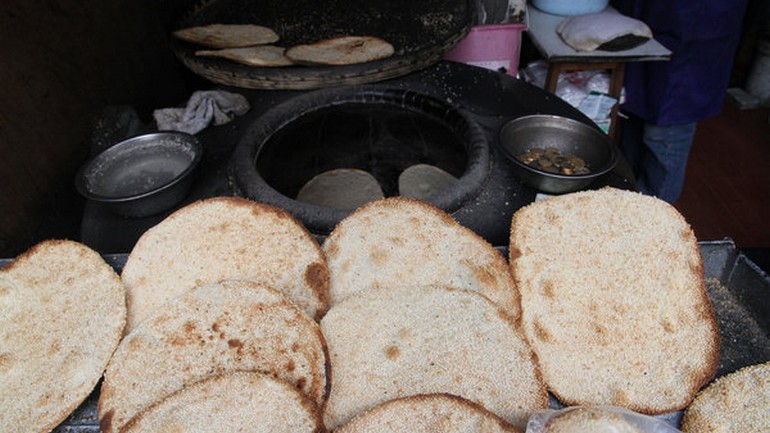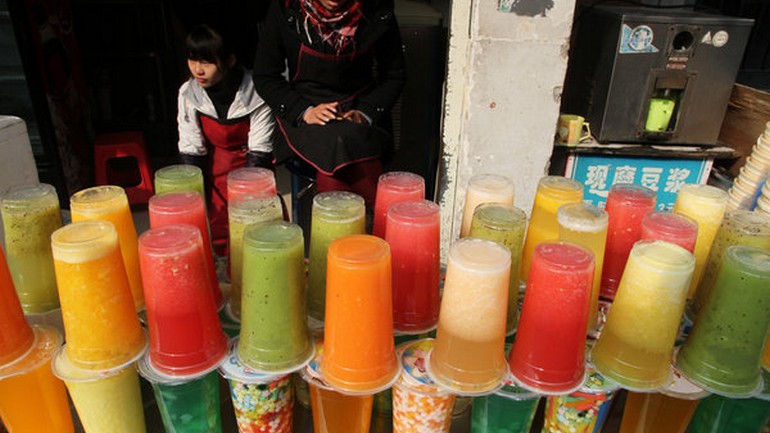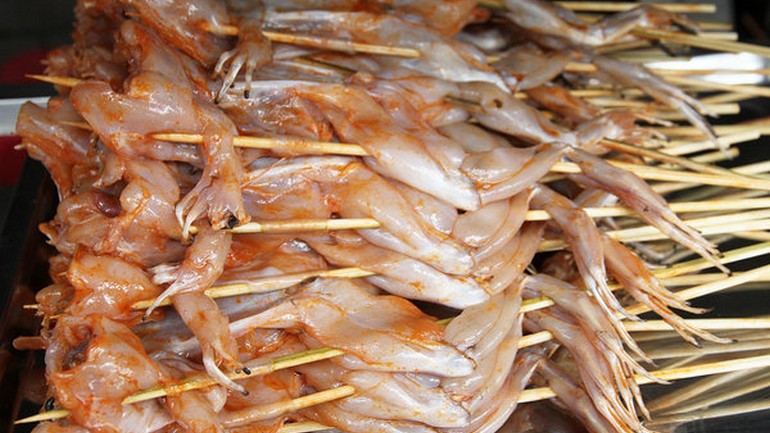Even the strictest of budget should allow for occasional splurges: a modest hotel room after a string of hostel bunks; a just-this-once late-night cab; a beer upgrade from P.B.R. to I.P.A. But some luxuries never enter the frugal equation. Take, for example, the restaurant tasting menu — those drawn-out dinners of 8 or 10 or 25 courses, exquisitely designed (and sometimes served) by the chef. Or so I’ve heard.
即使是最严格的预算也应该允许偶尔的挥霍:一连好几晚都住青年旅社的铺位之后,可以有一晚住普通的旅馆房间;“就这一次”在深夜坐出租车;可以有一次把啤酒从蓝带升级为印度爱尔啤酒。但是有些奢侈品永远不可能进入“穷游”的方程式里。比如餐馆的“精选菜单”——含有8道、10道或25道菜的漫长的晚餐,由大厨精心设计(有时甚至亲自上菜)。至少我听说的是这样的。
On my trip to South China this past winter, I finally found a tasting menu I could afford. It took some D.I.Y. initiative, but at a spot called Hubu Alley in Wuhan, I indulged in an eight-course meal that was a culinary tour of Hubei province. And all for just over $8. A dollar a course? No tax, no tip? Beat that, Le Bernardin.
去年冬天我去中国南方旅行的时候,终于找到了一个我能吃得起的“精选菜单”。这需要一点DIY精神,但是在武汉一个名叫“户部巷”的地方,我饱尝了一顿八道菜的大餐,简直可以说把湖北省的美食吃了个遍。而且总共只花了8美元。一道菜1美元?不用加税,不用给小费?认输吧,伯纳丁餐厅。
Hubu Alley isn’t a restaurant – it’s a T-shaped pedestrian area on the east side of the Yangtze, famed for the breakfast dishes sold by dozens of vendors from street carts and stalls. And designing my tasting menu could not have been more straightforward: I simply watched what other people were eating and followed suit.
户部巷不是个餐馆——它是一个T字型的步行街,位于长江东岸, 因几十个街边小摊和小铺售卖的早餐而闻名。设计我自己的“精选菜单”再简单不过了:我就是看别人吃什么,然后照着点。
So here it is: The 8-Course Hubu Alley Breakfast Tasting Menu.
下面就是户部巷早餐精选菜单的八道大菜:

Course 1: Cai lin ji (4 renminbi) – These “hot dry noodles” are the local breakfast standard, the bacon and eggs (or bagel and cream cheese) of Wuhan, and the original reason I came to the alley. My preboiled noodles were flash-dunked in hot water, then mixed with sesame paste, scallions, soy sauce and a few other dashes of vegetables and liquids I couldn’t identify. They were hearty, fresh and not too spicy. I could see why millions of Wuhan residents start their day with them.
第1道菜:蔡林记(4元)——“热干面”是当地的标准早餐,算是武汉的培根和鸡蛋(或者百吉饼和奶油干酪),也是我去那条小巷的初衷。提前煮好的面条在热水里过一下,然后加入芝麻酱、葱花、酱油和另外几种我叫不上名字的蔬菜和液体。热干面丰盛、鲜美,不太辣。我终于明白为什么成百上千万的武汉人要以吃这种面来开始新的一天。
Course 2: Dou pi (5 renminbi) – The No. 2 must-try breakfast in Wuhan is sticky rice mixed with other ingredients: vegetables and beans, in this case, wrapped in sheets of bean curd, then pan-fried until golden. The bean curd was tasty, but I discarded most of the rest; I’m just not Chinese enough to have both noodles and rice for breakfast.
第2道菜:豆皮(5元)——这是来武汉必须品尝的第2种早餐。它是把糯米和蔬菜、豆子等原料混合在一起,然后用豆皮卷起来,煎至金黄。豆皮很美味,但是里面裹的东西我大部分都给扔掉了。我还不够“中国化”,早餐不能又吃面条又吃大米。

Course 3: Xizang qingke bing (3.5 renminbi) – It was here, watching a man pull hot round flatbread covered in sesame seeds from what looked like a tandoor oven, that the idea for a tasting menu was born. I was already full enough to make it to lunch, but who can resist bread (Tibetan barley pancakes, actually) less than five seconds out of an oven? It was crispy around the edges, soft inside, and of course hot enough to burn the tongue and delicious enough to be worth it.
第3道菜:西藏青稞饼(3.5元)——我看见一个男人从一个筒状泥炉中取出一个发烫的圆形扁饼,上面布满了芝麻。就是在这时我产生了设计一个“精选菜单”的想法。我已经吃得够饱了,足以撑到午餐时间,但谁能抵挡住刚出炉5秒钟的面包(实际上是西藏大麦饼)呢?饼的四周很脆,中间柔软。它当然会烫到你的舌头,但同时又很美味,让你觉得这钱花得太值了。
Course 4: Won ton soup (5 renminbi) – Important travel rule: if you see a line, get in it first, ask questions later. But in Wuhan, questions (like “Do you speak English?”) are met with blank stares, so here, the story unfolded as I waited. Customers at Jiangming Hundun Guan handed over money to a man in a cart as two women at a nearby table carefully filled thin dough with minced pork and twisted them into tortellini-size dumplings. The man, wearing an apron that read “Wuhan Flavor Street,” prepared bowls of minced greens, black pepper and a dash of MSG for each prepaid customer, then waited for the dumplings to boil. In came the broth, and finally a sieve full of soft, juicy dumplings, perfect for a cold Wuhan winter morning.
第4道菜:馄饨(5元)——重要的旅行规则:如果你看到有人排队,那你就先排上,然后再提问。但是在武汉,提问(比如“你会说英语吗?”)只会碰上茫然的目光,所以在这里,我会在等待的过程中找到答案。江明馄饨馆的顾客们把钱交给推车边的一个男人,附近一张桌子边的两个女人小心地把绞碎的猪肉包到薄薄的面皮里,拧成意大利饺子大小的馄饨。那个男人穿着围裙,上面写着“武汉风情街”,他给每个付过钱的顾客备好碗,往碗里放入切碎的绿色蔬菜、黑胡椒和一点儿味精,然后等着馄饨煮熟。先舀入清汤,最后舀入满满一漏勺柔软、多汁的馄饨。在武汉寒冷的冬季的早晨,吃上这么一碗热腾腾的馄饨,真是太完美了。

Course 5: Papaya juice (8 renminbi) — Several vendors sold colorful juices, made on site and served bubble tea style, with cups sealed with foil on site and then punctured by a straw wide enough to allow passage of tapioca pearls, though there were none in mine. Call it a palate cleanser.
第5道菜:木瓜汁(8元)——有几个小贩售卖五颜六色的果汁,这些果汁都是现场制作,供应的方式像泡沫红茶。杯子现场用箔纸密封,然后用吸管刺破,吸管很粗,可以把木薯珍珠丸子吸上来,不过我的果汁里一个珍珠丸子也没有。这道菜算是用来清口的吧。

Course 6: Fried frog (12 renminbi) – It was time for a break, so I wandered the “alley” and its even more alleylike spur of even more tightly packed vendors, passing by others walking and munching who knows what. A teenage girl passed by, and in her case, I knew what she was carrying: a frog, decapitated and fried but still very recognizable, splayed open on two skewers. Just a few stalls down was the frog vendor, a young woman with three metal trays stacked with skewered frogs, complete with webbed toes and meaty thighs. I pointed, she fried, and, with sign language, asked if I wanted it snipped in two demi-frog popsicles. I did. There was a surprising amount of meat (poultrylike, as you have probably heard) and a wicked amount of spice (the equivalent of extra-fiery Buffalo wings). I found myself gnawing at the vertebra and wondered why the French stop at the legs.
第6道菜:煎牛蛙(12元)——该休息一下了,所以我在“小巷”里闲逛。小贩越来越多,一个挨着一个,路人们一边走一边大块朵颐,但我不知道他们吃的是什么。一个十多岁的女孩从我身边经过,她盒子里的东西我认出来了:牛蛙。尽管头被去掉了,而且被煎过了,但是仍然很好认,它四脚张开被串在两根烤肉扦上。卖牛蛙的小摊就在前面不远处,一个年轻女人面前摆着三个金属托盘,上面堆放着串好的牛蛙,这些牛蛙都有着完整的蹼趾和多肉的大腿。我指向其中一个,她煎好后,打手势问我要不要把它剪开,串在两根扦子上。我同意了。蛙肉多得让我感到意外(你很可能听说过,有点像禽肉),辣椒多得吓人(辣度相当于布法罗辣鸡翅中超辣的那种)。我发觉自己在啃牛蛙的脊柱,心想法国人为什么只吃蛙腿呢,真可惜。
Course 7: Doughnut holes (5 renminbi) – Thinking I was done eating, I figured it was time for dessert. I’ll call these doughnut holes because I don’t know the name in Chinese (feel free to comment below) but they were neither Dunkin’ Donuts cakey nor Krispy Kreme yeasty; instead, the outside felt a bit like an ultrathin layer of fiberglass (in a good way) and the inside was gooey and glutinous (in a very good way).
第7道菜:油炸圈饼(5元)——我正想着不吃别的了,忽然想到该吃甜品了。我把这种甜点称作“油炸圈饼”(其实是“糍粑面窝”——译注)是因为我不知道它中文叫什么(请在下面自由地发表你的看法吧)。它既不像“邓金甜甜圈”(Dunkin' Donuts)那么脆,也不像“卡卡圈坊”(Krispy Kreme)的甜甜圈那么蓬松。它的外面像一层超细玻璃纤维(很好吃),里面黏黏的(非常好吃)。
Course 8: Oysters (3 for 10 renminbi) – The doughnut-to-oyster shift should be done only under extreme circumstances, but these were those. Bloated, I attempted an exit, but noticed a crowd gathered around a man who was tending a narrow grill. I poked my head in, and saw he was spooning garlic onto oysters and scallops on the half-shell. (The scallops also got a bit of vermicelli.) The garlic mixed with the natural oyster juice and began to bubble. I had to make room for one last course.
第8道菜:烤生蚝(10元3个)——“从油炸圈饼到烤生蚝”的转换只能在极端情况下进行,但是当时就是极端情况。我肚子撑得不得了,想找个口出去,但是看到一群人聚在一个男人周围,他在照看一个窄窄的烤架。我把头探进去,看见他正舀着一小勺大蒜,往生蚝和扇贝上倒,扇贝还保留着一半的壳。(扇贝里还有一点儿粉丝。)大蒜与生蚝天然的汁液融合在一起,滋滋作响。我必须得腾出肚子吃最后一道大菜。
Since there was no waiter to relay my message at the time, allow me to send one remotely: Gongxi chushi shouyigao! (That’s Chinese for: My compliments to the chefs!)
当时没有服务员可以帮我传话,所以请允许我在这里送上遥远的赞美:恭喜厨师手艺高!(Gongxi chushi shouyigao! 这句中文的意思是:厨师的手艺真好!)



 闽公网安备 35020302035673号
闽公网安备 35020302035673号
0 responses on "In a Chinese Alley, an $8 Tasting Menu"